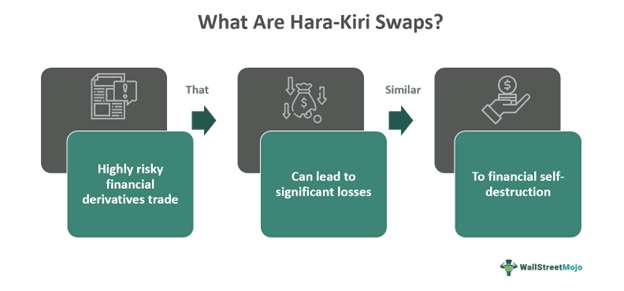Table of Contents
What Are Hara-Kiri Swaps?
Hara-Kiri swaps are cross-country currency-based financial instruments introduced by Japanese investors to attract foreign business and investment into the Japanese economy. In simple terms, two parties exchange currency to speculate the value for a specific time.

The Hara Kiri swaps originated in the 1980s with the sole purpose of attaining foreign investment and not earning profit. Swaps were popular among investors, but when the Japanese economy opened up to the world market, the attraction of such swaps declined drastically. "Hara-Kiri" literally means belly cutting, representing an ancient Japanese warrior culture.
Key Takeaways
- The Hara Kiri swaps are cross-country currency-based interest rate swaps introduced by Japanese investors in the 1980s.
- The meaning of Hara-Kiri lies in the Japanese suicide ritual practiced by Japanese samurais as a respectable way of self-execution, an alternative to disgraceful deaths.
- Since its inception, it gained popularity among investors, but after the World Trade Organization forced every nation to remove its trade barriers, the popularity of swaps declined enormously.
- Several swap contracts exist, like currency, credit default commodity, interest rate, and total return swaps.
Hara-Kiri Swaps Explained
Hara-Kiri swaps are cross-country financial derivatives that Japanese investors introduced to attract foreign investments into their domestic financial markets. It was done in the 1980s when many nations had several trade barriers. The history of the term "Hara-Kiri" goes back to the 12th-century ancient Japanese samurai warriors and their culture of self-disembowelment. The more common term used in Japan is seppuku.
In swap contracts, the value of swaps is deduced from another underlying asset. In simple terms, two parties agree to exchange cash flow or assets for a specific time. One party opts for a fixed interest, and the other chooses a floating interest rate. The swaps work on speculations made by both parties regarding the underlying assets' value; the correct one becomes profitable.
The Hara Kiri swaps brought many foreign investments to the Japanese markets, but soon, the World Trade Organization ordered many nations to remove their trade barriers for easy access and market globalization; Japan was one of them; soon after, the popularity of the Hara Kiri swaps declined. The Hara Kiri swaps were mostly interest-rate and currency-based swaps offered to other nations, allowing them to be involved in swap contracts with Japanese corporations. Though it has its profit benefits, introducing the swaps was to attract international currency and businesses close to the Japanese economy for growth. Still, it later disappeared in the herd of more significant financial instruments.
Examples
Below are two examples of Hara-Kiri Swaps –
Example #1
Suppose two friends, Harold and Kevin, run their businesses for a hypothetical example of Hara-Kiri swaps. A principal, settlement date, and other contract terms are agreed upon in interest rate swaps. Let us assume that Harold opts for a fixed interest rate and Kevin opts for a variable interest rate.
The principal amount was $18000. Harold chose a fixed interest rate of 4.5%, and Kevin opted for a floating interest rate like LIBOR for a contract period of two years. If at the end of the first year, the LIBOR is 3.6%, Harold is liable to the fixed interest of 4.5% on the principal of $18000, which is $810 to Kevin, but Kevin, on the other hand, is expected to pay 3.6% to Harold who is $648 based on the LIBOR.
Instead of swapping the actual interest amount, the profitable party will receive the net amount from the other party. Here, the net amount equals the difference between the interest payments.
810 - 648 = $162
In the end, Harold will pay Kevin $162.
Example #2
The principal amount is exchanged for foreign currency swaps as the other currency is required to conduct business in another country. The critical difference between interest rates and foreign currency swaps is that both parties have a fixed interest rate based on their borrowed foreign currency.
Suppose Jennifer runs a European company that requires $27000 and enters into a foreign currency swap with Hunley, who owns an American company, with an agreement to offer the same amount in Euros.
Jennifer and Hunely now had two different fixed interest rates, 4.5% and 2.7%, respectively. At the end of the year, Jennifer, who borrowed dollars, is liable to pay interest in dollars. Therefore, Jennifer will pay Hunley 4.5% of $27000 = 1215. On the contrary, Hunley will pay Jennifer 2.7% of 27000 Euros = 729. After the settlement term, the principal amount will be exchanged again regardless of the prevailing exchange rate.
Advantages And Disadvantages
Advantages of Hara-Kiri swaps –
- Swaps are cheap compared to other financial instruments and derivatives.
- It can be used to hedge long-term risks.
- Compared to futures and options, it has a long-term period.
- General swaps are popular in the US and are more convenient and easily accessible in the US financial markets.
- For some organizations, swap contracts allow them to maintain a set interest rate, commodity, or currency, which enables them to stabilize their financial position.
Disadvantages of Hara-Kiri swaps –
- Swaps are for the long term; therefore, a fee is incurred if interfered with, broken, or canceled in between.
- Short-term benefits are not possible.
- They are non-liquid financial instruments and bring a default risk factor.
